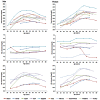Cholesterol and cardiovascular disease in the elderly. Facts and gaps
- PMID: 23730531
- PMCID: PMC3660125
Cholesterol and cardiovascular disease in the elderly. Facts and gaps
Abstract
Hypercholesterolemia is a major cardiovascular risk factor that increases the incidence of atherosclerotic diseases in adults, although the association is less well established in the elderly. The role of statins is well characterized for the reduction of myocardial infarction incidence or death in individuals with a history or high risk of cardiovascular diseases, regardless of age. Therapeutic measures recommended to prevent cardiovascular diseases and to reduce cholesterol levels in the elderly, such as lifestyle changes and lipid-lowering drugs, particularly statins, are based on studies conducted in younger adults. This narrative review aims to summarize the main observational studies and randomized clinical trials that have studied the relationship between cholesterol and cardiovascular diseases and the potential benefits and drawbacks of statins use in elderly patients.
Keywords: aged; cardiovascular disease; coronary artery disease; hypercholesterolemia; peripheral arterial disease; stroke.
Figures


References
-
- Expert panel on detection, evaluation, and treatment of high blood cholesterol in adults (ATP III) Third report of the National Cholesterol Education Program (NCEP). Final report. Circulation. 2002;106:3143–21. - PubMed
-
- Stary HC, Chandler B, Glagov S, Guyton JR, Insull W, Rosenfeld ME, et al. A definition of initial, fatty streak, and intermediate lesions of atherosclerosis: a report from the Committee on Vascular Lesions of the Council on Arteriosclerosis, American Heart Association. Arterioscler Thromb. 1994;14:840–56. - PubMed
-
- Stary HC, Chandler AB, Dinsmore RE, Fuster V, Glagov S, Insull W, et al. A definition of advanced types of atherosclerotic lesions and a histological classification of atherosclerosis: a report from the Committee on Vascular Lesions of the Council on Arterioclerosis, American Heart Association. Arterioscler Thromb Vasc Biol. 1995;15:1512–31. - PubMed
-
- Dzau VJ, Antman EM, Black HR, Hayes DL, Manson JE, Plutzky J, et al. The cardiovascular disease continuum validated: clinical evidence of improved patient outcome: Part I: Pathophysiology and clinical trial evidence (Risk factors through stable coronary disease) Circulation. 2006;114:2850–70. - PubMed
-
- Ross R. Atherosclerosis: an inflammatory disease. N Eng J Med. 1999;340:115–26. - PubMed
LinkOut - more resources
Full Text Sources
